Flocculant-Assisted Synthesis of Graphene-Like Carbon Nanosheets for Oxygen Reduction Reaction and Supercapacitor
Abstract
1. Introduction
2. Experimental
2.1. Chemicals
2.2. Preparation of Chitosan-Containing Textile Sludge
2.3. Preparation of NSC-Fe
2.4. Characterization
2.5. Electrochemical Measurements
3. Results and Discussion
3.1. Flocculation Performance
3.2. Characterization of Samples
3.3. Oxygen Reduction Reaction (ORR) Activity
3.4. Supercapacitor Performance
4. Conclusions
Supplementary Materials
Author Contributions
Funding
Acknowledgments
Conflicts of Interest
References
- Tian, D.; Zhang, X.; Lu, C.; Yuan, G.; Zhang, W.; Zhou, Z. Solvent-free synthesis of carboxylate-functionalized cellulose from waste cotton fabrics for the removal of cationic dyes from aqueous solutions. Cellulose 2013, 21, 473–484. [Google Scholar] [CrossRef]
- Cai, T.; Li, H.; Yang, R.; Wang, Y.; Li, R.; Yang, H.; Li, A.; Cheng, R. Efficient flocculation of an anionic dye from aqueous solutions using a cellulose-based flocculant. Cellulose 2015, 22, 1439–1449. [Google Scholar] [CrossRef]
- Salleh, M.A.M.; Mahmoud, D.K.; Karim, W.A.W.A.; Idris, A. Cationic and anionic dye adsorption by agricultural solid wastes: A comprehensive review. Desalination 2011, 280, 1–13. [Google Scholar] [CrossRef]
- Guo, J.; Zhou, J.; Wang, D.; Tian, C.; Wang, P.; Uddin, M.S. A novel moderately halophilic bacterium for decolorizing azo dye under high salt condition. Biodegradation 2008, 19, 15–19. [Google Scholar] [CrossRef] [PubMed]
- Sun, D.; Zhang, X.; Du, H.; Fang, L.; Jiang, P. Application of liquid organic salt to cotton dyeing process with reactive dyes. Fibers Polym. 2017, 18, 1969–1974. [Google Scholar] [CrossRef]
- Paz, A.; Carballo, J.; Pérez, M.J.; Domínguez, J.M. Biological treatment of model dyes and textile wastewaters. Chemosphere 2017, 181, 168–177. [Google Scholar] [CrossRef]
- Yang, G.; Zhang, G.; Wang, H. Current state of sludge production, management, treatment and disposal in China. Water Res. 2015, 78, 60–73. [Google Scholar] [CrossRef]
- Riera-Torres, M.; Gutiérrez-Bouzán, C.; Crespi, M. Combination of coagulation-flocculation and nanofiltration techniques for dye removal and water reuse in textile effluents. Desalination 2010, 252, 53–59. [Google Scholar] [CrossRef]
- Lotito, A.M.; De Sanctis, M.; Di Iaconi, C.; Bergna, G. Textile wastewater treatment: Aerobic granular sludge vs activated sludge systems. Water Res. 2014, 54, 337–346. [Google Scholar] [CrossRef]
- Bogush, A.A.; Stegemann, J.A.; Roy, A. Changes in composition and lead speciation due to water washing of air pollution control residue from municipal waste incineration. J. Hazard. Mater. 2019, 361, 187–199. [Google Scholar] [CrossRef]
- Lei, Z.; Feng, W.; Feng, C.; Zhou, W.; Wei, C.-H.; Wang, X. Nitrified coke wastewater sludge flocs: Attractive precursor for N, S dual-doped graphene-like carbon with ultrahigh capacitance and oxygen reduction performance. J. Mater. Chem. A 2017, 5, 2012–2020. [Google Scholar] [CrossRef]
- Wong, S.; Yac’cob, N.A.N.; Ngadi, N.; Hassan, O.; Inuwa, I.M. From pollutant to solution of wastewater pollution: Synthesis of activated carbon from textile sludge for dye adsorption. Chin. J. Chem. Eng. 2018, 26, 870–878. [Google Scholar] [CrossRef]
- Kaçan, E.; Kütahyalı, C. Adsorption of strontium from aqueous solution using activated carbon produced from textile sewage sludges. J. Anal. Appl. Pyrolysis 2012, 97, 149–157. [Google Scholar] [CrossRef]
- Ma, X.; Feng, C.; Zhou, W.; Yu, H. Municipal sludge-derived carbon anode with nitrogen- and oxygen-containing functional groups for high-performance microbial fuel cells. J. Power Sources 2016, 307, 105–111. [Google Scholar] [CrossRef]
- Mendoza-Sánchez, B.; Gogotsi, Y. Synthesis of two-dimensional materials for capacitive energy storage. Adv. Mater. 2016, 28, 6104–6135. [Google Scholar] [CrossRef] [PubMed]
- Torrisi, F.; Carey, T. Graphene, related two-dimensional crystals and hybrid systems for printed and wearable electronics. Nano Today 2018, 23, 73–96. [Google Scholar] [CrossRef]
- Primo, A.; Atienzar, P.; Sanchez, E.; Delgado, J.M.; García, H. From biomass wastes to large-area, high-quality, N-doped graphene: Catalyst-free carbonization of chitosan coatings on arbitrary substrates. Chem. Commun. 2012, 48, 9254–9256. [Google Scholar] [CrossRef] [PubMed]
- Hao, P.; Zhao, Z.; Leng, Y.; Tian, J.; Sang, Y.; Boughton, R.I.; Wong, C.P.; Liu, H.; Yang, B. Graphene-based nitrogen self-doped hierarchical porous carbon aerogels derived from chitosan for high performance supercapacitors. Nano Energy 2015, 15, 9–23. [Google Scholar] [CrossRef]
- Namboodiri, M.M.T.; Pakshirajan, K. Sustainable and green approach of chitosan production from Penicillium citrinum biomass using industrial wastewater as a cheap substrate. J. Environ. Manag. 2019, 240, 431–440. [Google Scholar] [CrossRef]
- Wei, T.; Wu, L.; Yu, F.; Lv, Y.; Chen, L.; Shi, Y.; Dai, B. pH-responsive chitosan-based flocculant for precise dye flocculation control and the recycling of textile dyeing effluents. RSC Adv. 2018, 8, 39334–39340. [Google Scholar] [CrossRef]
- Ma, H.; Kong, A.; Ji, Y.; He, B.; Song, Y.; Li, J. Ultrahigh adsorption capacities for anionic and cationic dyes from wastewater using only chitosan. J. Clean. Prod. 2019, 214, 89–94. [Google Scholar] [CrossRef]
- Atarod, M.; Nasrollahzadeh, M.; Mohammad Sajadi, S. Green synthesis of Pd/RGO/Fe3O4 nanocomposite using Withania coagulans leaf extract and its application as magnetically separable and reusable catalyst for the reduction of 4-nitrophenol. J. Colloid Interface Sci. 2016, 465, 249–258. [Google Scholar] [CrossRef] [PubMed]
- Zhao, C.; Shao, X.; Zhu, Z.; Zhao, C.; Qian, X. One-pot hydrothermal synthesis of RGO/FeS composite on Fe foil for high performance supercapacitors. Electrochim. Acta 2017, 246, 497–506. [Google Scholar] [CrossRef]
- Zhou, H.-Y.; Sui, Z.-Y.; Liu, S.; Wang, H.-Y.; Han, B.-H. Nanostructured porous carbons derived from nitrogen-doped graphene nanoribbon aerogels for lithium–sulfur batteries. J. Colloid Interface Sci. 2019, 541, 204–212. [Google Scholar] [CrossRef] [PubMed]
- Wang, T.; Wang, L.; Wu, D.; Xia, W.; Zhao, H.; Jia, D. Hydrothermal synthesis of nitrogen-doped graphene hydrogels using amino acids with different acidities as doping agents. J. Mater. Chem. A 2014, 2, 8352–8361. [Google Scholar] [CrossRef]
- Sun, X.; Zhang, Y.; Song, P.; Pan, J.; Zhuang, L.; Xu, W.; Xing, W. Fluorine-doped carbon blacks: Highly efficient metal-free electrocatalysts for oxygen reduction reaction. ACS Catal. 2013, 3, 1726–1729. [Google Scholar] [CrossRef]
- Ahn, S.H.; Yu, X.; Manthiram, A. “Wiring” Fe-Nx-Embedded porous carbon framework onto 1d nanotubes for efficient oxygen reduction reaction in alkaline and acidic media. Adv. Mater. 2017, 29, 1606534. [Google Scholar] [CrossRef]
- Shah, S.S.A.; Najam, T.; Cheng, C.; Peng, L.; Xiang, R.; Zhang, L.; Deng, J.; Ding, W.; Wei, Z. Exploring Fe-Nx for peroxide reduction: Template-free synthesis of Fe-Nx traumatized mesoporous carbon nanotubes as an ORR catalyst in acidic and alkaline solutions. Chem. Eur. J. 2018, 24, 10630–10635. [Google Scholar] [CrossRef]
- Tian, Y.; Xu, L.; Qian, J.; Bao, J.; Yan, C.; Li, H.; Li, H.; Zhang, S. Fe3C/Fe2O3 heterostructure embedded in N-doped graphene as a bifunctional catalyst for quasi-solid-state zinc–air batteries. Carbon 2019, 146, 763–771. [Google Scholar] [CrossRef]
- Zhang, J.; Chen, G.; Zhang, Q.; Kang, F.; You, B. Self-assembly synthesis of N-doped carbon aerogels for supercapacitor and electrocatalytic oxygen reduction. ACS Appl. Mater. Interfaces 2015, 723, 12760–12766. [Google Scholar] [CrossRef]
- Zhou, T.; Ma, R.; Zhang, T.; Li, Z.; Yang, M.; Liu, Q.; Zhu, Y.; Wang, J. Increased activity of nitrogen-doped graphene-like carbon sheets modified by iron doping for oxygen reduction. J. Colloid Interface Sci. 2019, 536, 42–52. [Google Scholar] [CrossRef]
- Song, K.; Shi, B.; Song, D.; Zhang, Q.; He, X.; Dou, Z.; Hu, X.; Cui, L. Tunable engineering hollow carbon nanomaterial served as an excellent catalyst for oxygen reduction reaction and hydrogen evolution reaction. J. Colloid Interface Sci. 2019, 544, 178–187. [Google Scholar] [CrossRef]
- Yang, Z.K.; Lin, L.; Xu, A.W. 2D nanoporous Fe-N/C nanosheets as highly efficient non-platinum electrocatalysts for oxygen reduction reaction in Zn-Air battery. Small 2016, 12, 5710–5719. [Google Scholar] [CrossRef]
- Chen, C.; Xu, G.; Wei, X.; Yang, L. A macroscopic three-dimensional tetrapod-separated graphene-like oxygenated N-doped carbon nanosheet architecture for use in supercapacitors. J. Mater. Chem. A 2016, 4, 9900–9909. [Google Scholar] [CrossRef]
- Liu, Q.; Zhou, Y.; Chen, S.; Wang, Z.; Hou, H.; Zhao, F. Cellulose-derived nitrogen and phosphorus dual-doped carbon as high performance oxygen reduction catalyst in microbial fuel cell. J. Power Sources 2015, 273, 1189–1193. [Google Scholar] [CrossRef]
- Lei, H.; Yan, T.; Wang, H.; Shi, L.-Y.; Zhang, J.; Zhang, D. Graphene-like carbon nanosheets prepared by a Fe-catalyzed glucose-blowing method for capacitive deionization. J. Mater. Chem. A 2015, 3, 5934–5941. [Google Scholar] [CrossRef]
- Jiang, H.; Yao, Y.; Zhu, Y.; Liu, Y.; Su, Y.; Yang, X.; Li, C. Iron carbide nanoparticles encapsulated in mesoporous Fe-N-Doped graphene-like carbon hybrids as efficient bifunctional oxygen electrocatalysts. ACS Appl. Mater. Interfaces 2015, 7, 21511–21520. [Google Scholar] [CrossRef]
- Zhang, X.; Wang, X.; Le, L.; Ma, A.; Lin, S. Electrochemical growth of octahedral Fe3O4 with high activity and stability toward the oxygen reduction reaction. J. Mate. Chem. A 2015, 3, 19273–19276. [Google Scholar] [CrossRef]
- He, D.; Zhao, W.; Li, P.; Sun, S.; Tan, Q.; Han, K.; Liu, L.; Liu, L.; Qu, X. Bifunctional biomass-derived N, S dual-doped ladder-like porous carbon for supercapacitor and oxygen reduction reaction. J. Alloys Compd. 2019, 773, 11–20. [Google Scholar] [CrossRef]
- Artyushkova, K.; Serov, A.; Doan, H.; Danilovic, N.; Capuano, C.B.; Sakamoto, T.; Kishi, H.; Yamaguchi, S.; Mukerjee, S.; Atanassov, P. Application of X-ray photoelectron spectroscopy to studies of electrodes in fuel cells and electrolyzers. J. Electron Spectrosc. Relat. Phenom. 2019, 231, 127–139. [Google Scholar] [CrossRef]
- Hossen, M.M.; Artyushkova, K.; Atanassov, P.; Serov, A. Synthesis and characterization of high performing Fe-N-C catalyst for oxygen reduction reaction (ORR) in alkaline exchange membrane fuel cells. J. Power Sources 2018, 375, 214–221. [Google Scholar] [CrossRef]
- Wang, H.; Wang, W.; Gui, M.; Asif, M.; Wang, Z.; Yu, Y.; Xiao, J.; Liu, H. Uniform Fe3O4/Nitrogen-Doped mesoporous carbon spheres derived from ferric citrate-bonded melamine resin as an efficient synergistic catalyst for oxygen reduction. ACS Appl. Mater. Interfaces 2017, 9, 335–344. [Google Scholar] [CrossRef]
- Kim, D.; Zussblatt, N.P.; Chung, H.T.; Becwar, S.M.; Zelenay, P.; Chmelka, B.F. Highly graphitic mesoporous Fe,N-Doped carbon materials for oxygen reduction electrochemical catalysts. ACS Appl. Mater. Interfaces 2018, 10, 25337–25349. [Google Scholar] [CrossRef]
- Ferrandon, M.; Kropf, A.J.; Myers, D.J.; Artyushkova, K.; Kramm, U.; Bogdanoff, P.; Wu, G.; Johnston, C.M.; Zelenay, P. Multitechnique characterization of a Polyaniline–Iron–Carbon oxygen reduction catalyst. J. Phys. Chem. C 2012, 116, 16001–16013. [Google Scholar] [CrossRef]
- Artyushkova, K.; Serov, A.; Rojas-Carbonell, S.; Atanassov, P. Chemistry of multitudinous active sites for oxygen reduction reaction in transition Metal–Nitrogen–Carbon electrocatalysts. J. Phys. Chem. C 2015, 119, 25917–25928. [Google Scholar] [CrossRef]
- Mao, N.; Wang, H.; Sui, Y.; Cui, Y.; Pokrzywinski, J.; Shi, J.; Liu, W.; Chen, S.; Wang, X.; Mitlin, D. Extremely high-rate aqueous supercapacitor fabricated using doped carbon nanoflakes with large surface area and mesopores at near-commercial mass loading. Nano Res. 2017, 10, 1767–1783. [Google Scholar] [CrossRef]
- Zheng, X.; Wu, J.; Cao, X.; Abbott, J.; Jin, C.; Wang, H.; Strasser, P.; Yang, R.; Chen, X.; Wu, G. N-, P-, and S-doped graphene-like carbon catalysts derived from onium salts with enhanced oxygen chemisorption for Zn-air battery cathodes. Appl. Catal. B Environ. 2019, 241, 442–451. [Google Scholar] [CrossRef]
- Guo, M.; Balamurugan, J.; Li, X.; Kim, N.H.; Lee, J. Hierarchical 3D cobalt-doped Fe3O4 Nanospheres@NG hybrid as an advanced anode material for high-performance asymmetric supercapacitors. Small 2017, 13, 1701275. [Google Scholar] [CrossRef]
- Hou, J.; Cao, C.; Idrees, F.; Ma, X. Hierarchical porous nitrogen-doped carbon nanosheets derived from silk for ultrahigh capacity battery anodes and supercapacitors. ACS Nano 2015, 9, 2556–2564. [Google Scholar] [CrossRef]
- Li, Y.; Wang, G.; Wei, T.; Fan, Z.; Yan, P. Nitrogen and sulfur co-doped porous carbon nanosheets derived from willow catkin for supercapacitors. Nano Energy 2016, 19, 165–175. [Google Scholar] [CrossRef]
- Chen, Z.-Y.; Liu, H.; Zhang, L.-C.; Li, Q.-L.; Xu, M.-W.; Bao, S.-J. Facile and scale synthesis of Co/N/S-Doped porous graphene-like carbon architectures as electrocatalysts for sustainable Zinc-Air battery cells. ACS Sustain. Chem. Eng. 2019, 7, 7743–7749. [Google Scholar] [CrossRef]
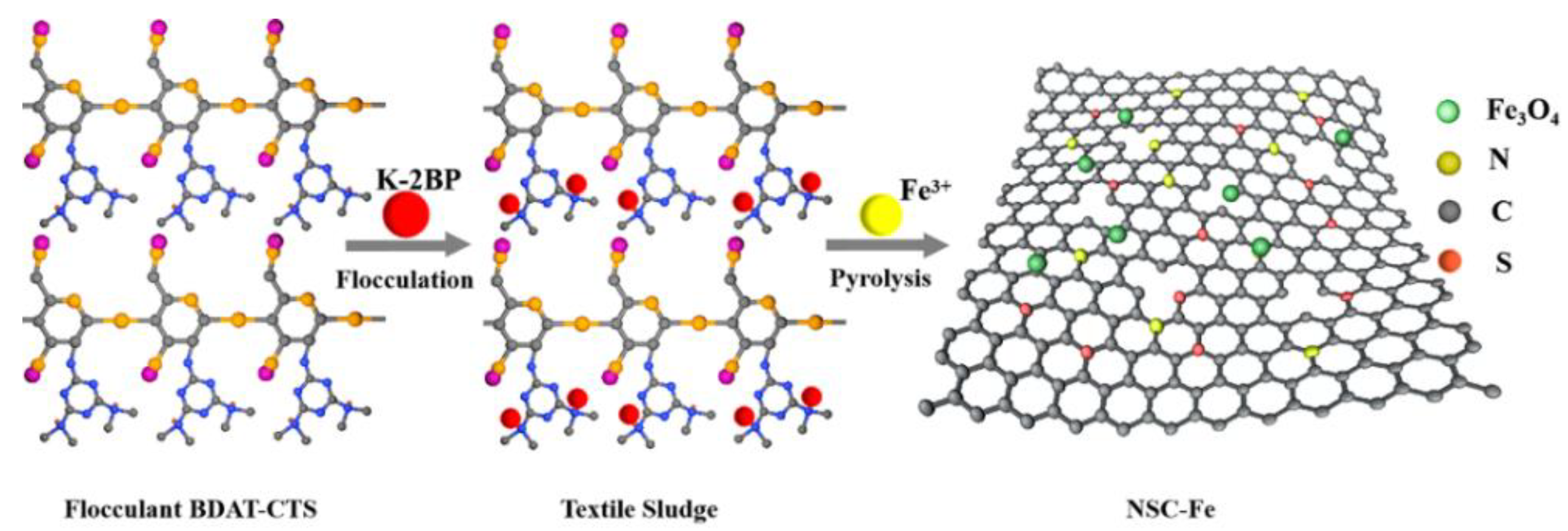
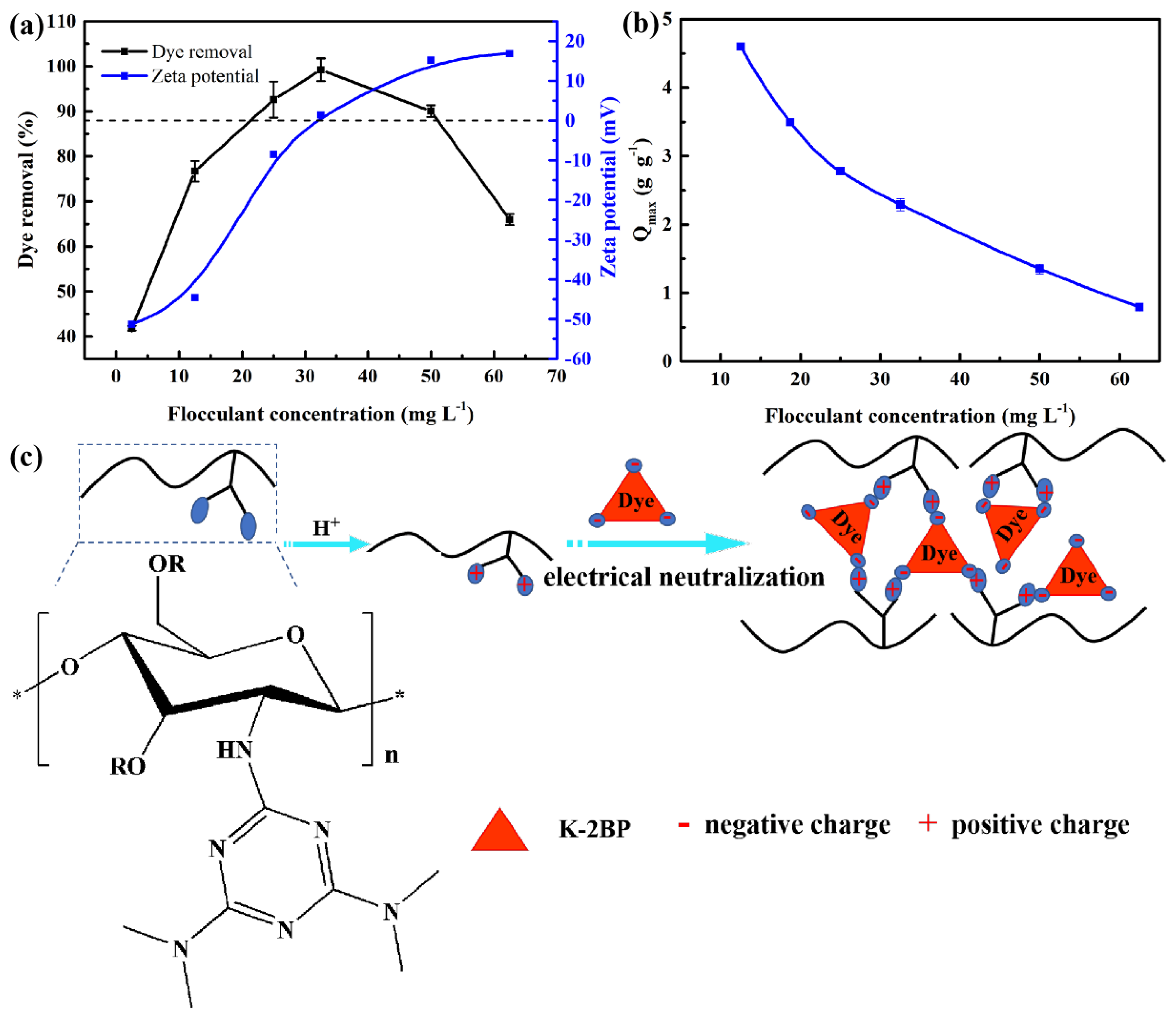
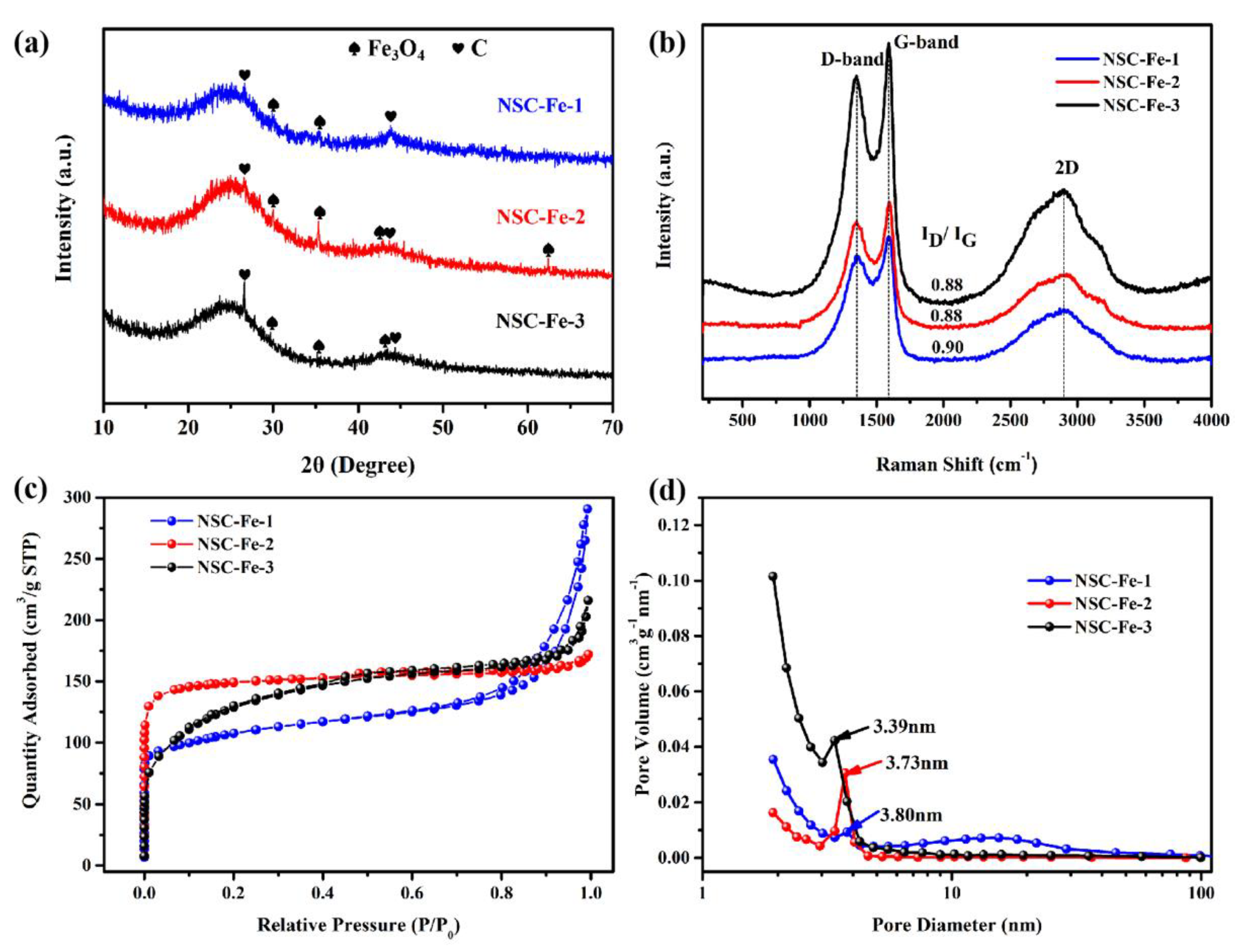
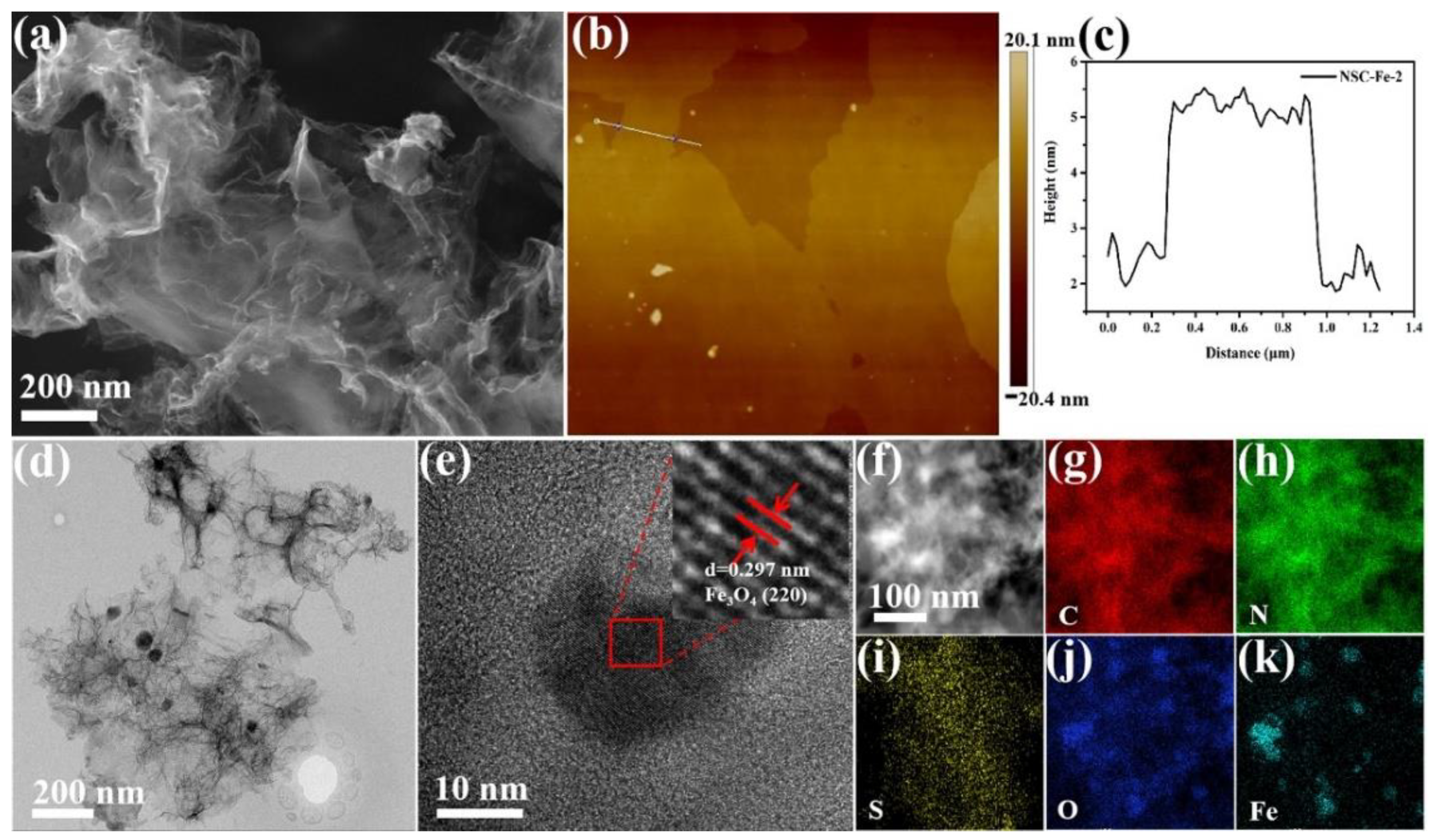

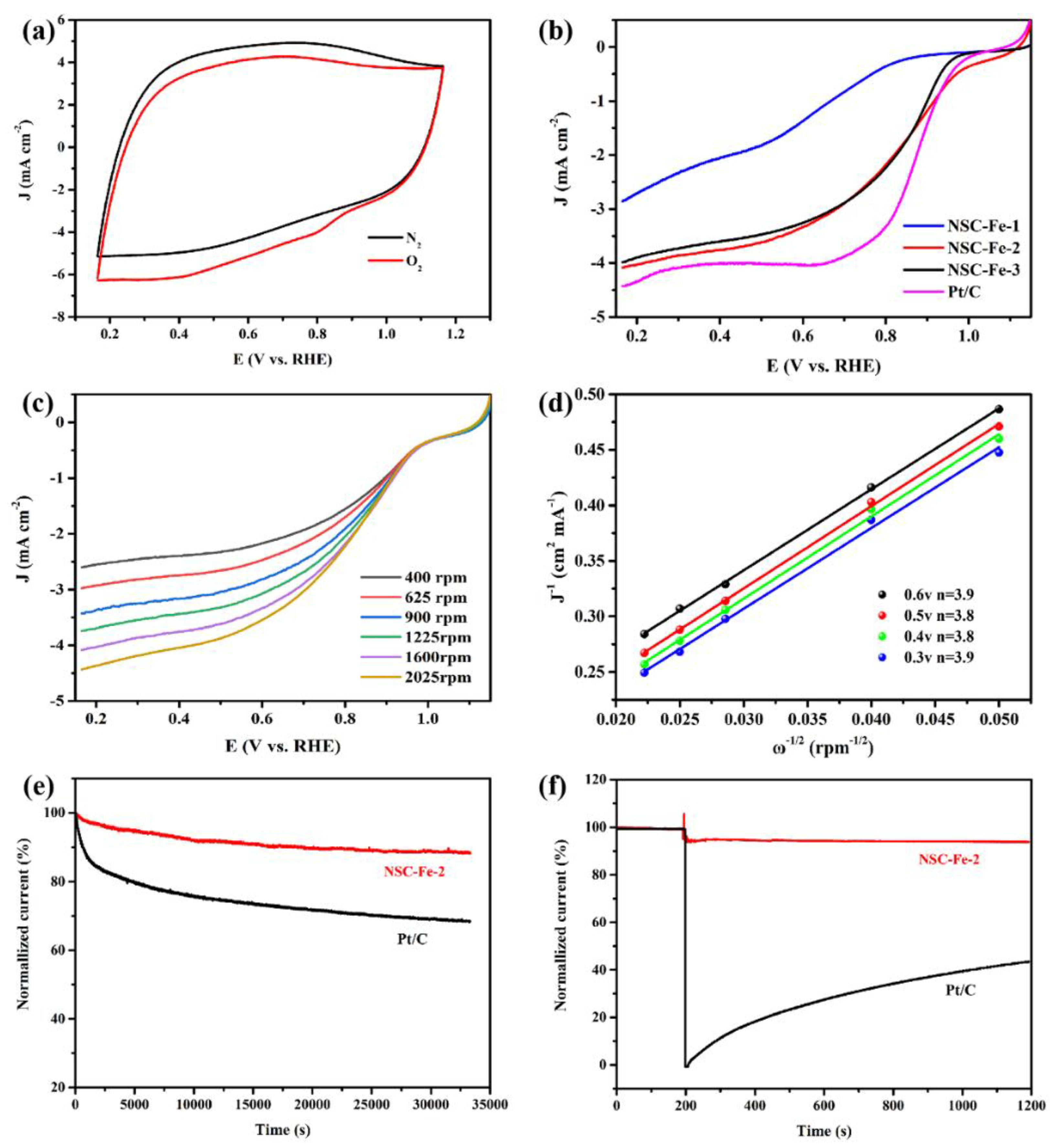
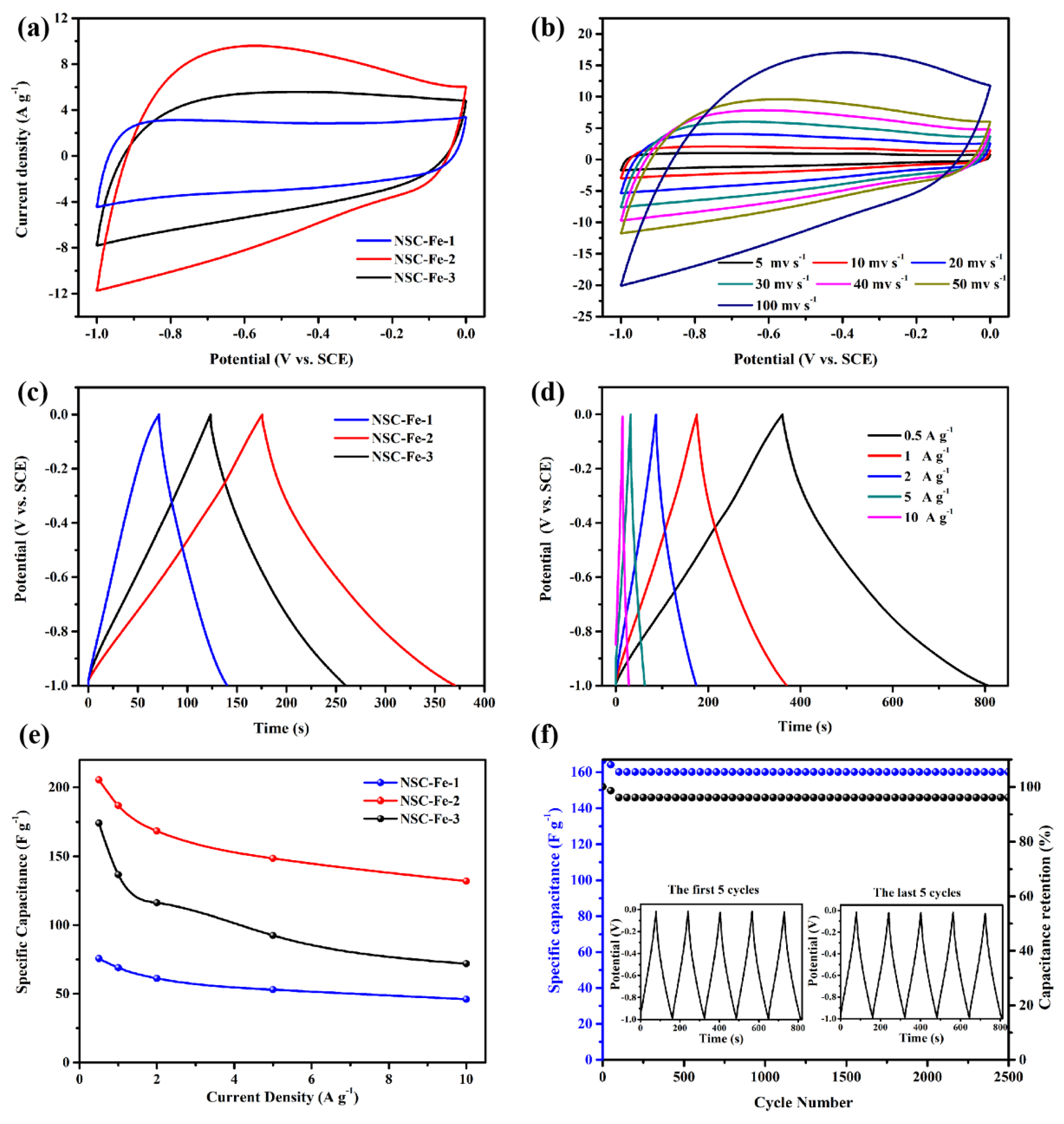
© 2019 by the authors. Licensee MDPI, Basel, Switzerland. This article is an open access article distributed under the terms and conditions of the Creative Commons Attribution (CC BY) license (http://creativecommons.org/licenses/by/4.0/).
Share and Cite
Zhang, Y.; Shi, Y.; Yan, B.; Wei, T.; Lv, Y.; Chen, L.; Yu, F.; Guo, X. Flocculant-Assisted Synthesis of Graphene-Like Carbon Nanosheets for Oxygen Reduction Reaction and Supercapacitor. Nanomaterials 2019, 9, 1135. https://doi.org/10.3390/nano9081135
Zhang Y, Shi Y, Yan B, Wei T, Lv Y, Chen L, Yu F, Guo X. Flocculant-Assisted Synthesis of Graphene-Like Carbon Nanosheets for Oxygen Reduction Reaction and Supercapacitor. Nanomaterials. 2019; 9(8):1135. https://doi.org/10.3390/nano9081135
Chicago/Turabian StyleZhang, Yinglin, Yulin Shi, Bo Yan, Tingting Wei, Yin Lv, Long Chen, Feng Yu, and Xuhong Guo. 2019. "Flocculant-Assisted Synthesis of Graphene-Like Carbon Nanosheets for Oxygen Reduction Reaction and Supercapacitor" Nanomaterials 9, no. 8: 1135. https://doi.org/10.3390/nano9081135
APA StyleZhang, Y., Shi, Y., Yan, B., Wei, T., Lv, Y., Chen, L., Yu, F., & Guo, X. (2019). Flocculant-Assisted Synthesis of Graphene-Like Carbon Nanosheets for Oxygen Reduction Reaction and Supercapacitor. Nanomaterials, 9(8), 1135. https://doi.org/10.3390/nano9081135





